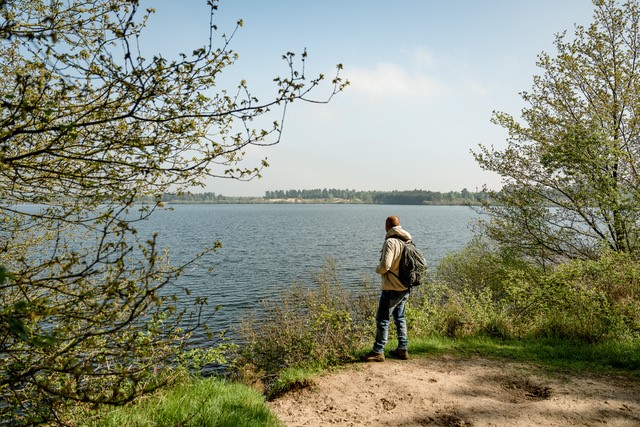On January 9, the National Parks Bureau and the Collective Nature Inclusive presented the Guide to National Parks as a Catalyst for Health. Some national parks are already applying this guide. What is the current situation? And what can other parks learn from this?
National Park Utrechtse Heuvelrug (NPUH)
To gain insight into what is happening regarding health and nature in the National Park Utrechtse Heuvelrug and the role the park can play, exploratory and in-depth discussions have been held with various parties from the region in recent months.
On April 14, a workshop took place with representatives from municipalities, the province, land-managing organizations, the Youth Council NPUH, and the Vrije Universiteit. During this meeting, a shared sense of urgency emerged about loneliness among young and elderly people, reduced mobility, and confused behavior. Especially loneliness, which affects all age groups, calls for broad involvement.
At the same time, it became clear that more connection is needed between the social domain, including health, and the physical domain of nature. There is a clear wish to especially focus on neighborhoods with a low socioeconomic status, where the barriers to visiting nature can be lowered. The focus is also on areas close to home and transition areas, places where urban areas meet nature.
The insights gathered so far will be translated into one or more concrete pilots with stakeholders in the area in the near future. The aim is to make nature more accessible, even close to home, to encourage interaction, and to contribute to the health of residents.
National Park Zuid-Kennemerland
National Park Zuid-Kennemerland makes a clear connection with the Regional Deal MRA-West, which focuses on Broad Prosperity, including a healthy living environment. From these encounters, the national park is currently exploring two concrete collaborations:
- A broad collaboration around 'Well-being on prescription,' 'Nature on prescription,' and a neighborhood-focused approach.
- An exploration with Zorgbalans within the theme Social Approach Dementia: how can we create more connection with nature from this valuable form of care?
Additionally, the national park sees possibilities for collaboration with Nieuw Unicum, an organization for people with MS or acquired brain injury. Their location is on the edge of the national park and adjacent to the Amsterdamse Waterleidingduinen. The large garden around their location requires a lot of maintenance. The national park is currently exploring how it can collaborate with various target groups and organizations in this, for example through joint garden maintenance.
Finally, it is being explored with the rangers in and around the national park whether they can play a role in passing on knowledge and expertise.
Van Gogh National Park
Ten involved partners reported to Van Gogh National Park to think about and contribute input on the relationship between Nature & Health. They mainly want to work on mental health, prevention, and focus on positive health. The target group of young people is specifically mentioned here.
On May 12, a workshop took place with various partners, including IVN, NFH, Het Groene Woud, Staatsbosbeheer, several municipalities, the province, and Avans University of Applied Sciences. During this meeting, vulnerable young people, caregivers, and neighborhood residents emerged as important target groups. Partners spoke with each other about joint efforts and possible projects. A recurring theme was involving students and young people. The partners are looking at how they can actively contribute to projects, for example through a 'living lab,' in which students develop solutions within Van Gogh National Park. They also consider setting up vitality programs by and for young people, focusing on themes like nutrition, health, nature, and lifestyle.
Additionally, the Green Escape program possibly provides valuable guidelines for youth projects. Other promising concepts also emerged, such as: Neighborhood-focused approach, Healthy neighborhoods, and Nature on prescription. Van Gogh National Park can play an important role in this as a connector and catalyst. The national park can set up concrete programs together with the involved parties that connect nature and health.
National Park Dunes of Texel
National Park Dunes of Texel aims for sustainable, regional cooperation on Texel, where nature and health go hand in hand. To align well with what is happening, the national park has held talks in recent months with municipalities, healthcare providers, welfare organizations, and volunteer initiatives. The focus is on connecting existing initiatives and strengthening the collaboration between organizations and the many active volunteers on the island. From the initial discussions and a joint kick-off meeting, the following opportunities emerged:
- Strengthening the collaboration between 'Well-being on Prescription' and 'Nature on Prescription,' with the municipality and the National Park working together;
- Inventorying and bundling organizations, with special attention to the connection with walking groups and the involvement of volunteers;
- Developing physical activities for young children, aimed at strengthening their contact with nature and improving resistance through exposure to healthy soil organisms.
National Park Dunes of Texel wants to be an inspiring example for other national parks by 2026. That year, the national park is hosting a (mini)symposium around the above themes, further promoting the island's pioneering role.
Project leader Niels Reinders is assisting the aforementioned parks with this. This is done on behalf of the National Parks Office with support from the Collective Nature Inclusive, health domain. In other national parks, nature and health are also important themes. For example, in National Park De Maasduinen, where general practitioner Hans Peter Jung from Afferden, along with IVN, encourages prescribing nature more often as medicine. Meanwhile, the so-called biowalks have been a success. Or the opening of a mindfulness route in National Park De Alde Faenen.
In the beautiful developments described above, national parks mainly serve as catalysts and connectors. There is much enthusiasm and confidence to firmly link nature and health with the goal of a healthy living environment for everyone. In a time of austerity and cutbacks, concrete results may take some time to manifest, but the first steps have been taken. Where there's a will, there's a way, and beautiful collaborations in national parks can arise.
